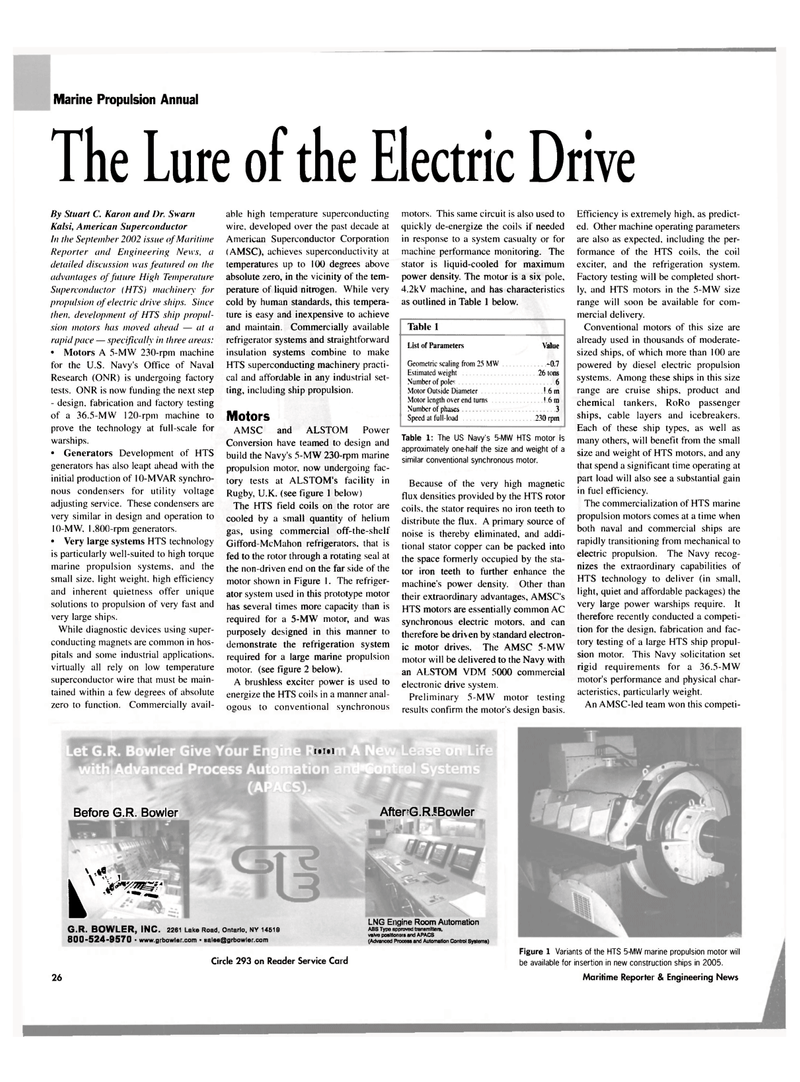
Page 26: of Maritime Reporter Magazine (September 2003)
Read this page in Pdf, Flash or Html5 edition of September 2003 Maritime Reporter Magazine
Marine Propulsion Annual
The Lure of the Electric Drive
By Stuart C. Karon and Dr. Swarn
Kalsi, American Superconductor
In the September 2002 issue of Maritime
Reporter and Engineering News, a detailed discussion was featured on the advantages of future High Temperature
Superconductor (HTS) machinery for propulsion of electric drive ships. Since then, development of HTS ship propul- sion motors has moved ahead — at a rapid pace — specifically in three areas: • Motors A 5-MW 230-rpm machine for the U.S. Navy's Office of Naval
Research (ONR) is undergoing factory tests. ONR is now funding the next step - design, fabrication and factory testing of a 36.5-MW 120-rpm machine to prove the technology at full-scale for warships. • Generators Development of HTS generators has also leapt ahead with the initial production of 10-MVAR synchro- nous condensers for utility voltage adjusting service. These condensers are very similar in design and operation to 10-MW, 1,800-rpm generators. • Very large systems HTS technology is particularly well-suited to high torque marine propulsion systems, and the small size, light weight, high efficiency and inherent quietness offer unique solutions to propulsion of very fast and very large ships.
While diagnostic devices using super- conducting magnets are common in hos- pitals and some industrial applications, virtually all rely on low temperature superconductor wire that must be main- tained within a few degrees of absolute zero to function. Commercially avail- able high temperature superconducting wire, developed over the past decade at
American Superconductor Corporation (AMSC), achieves superconductivity at temperatures up to 100 degrees above absolute zero, in the vicinity of the tem- perature of liquid nitrogen. While very cold by human standards, this tempera- ture is easy and inexpensive to achieve and maintain. Commercially available refrigerator systems and straightforward insulation systems combine to make
HTS superconducting machinery practi- cal and affordable in any industrial set- ting, including ship propulsion.
Motors
AMSC and ALSTOM Power
Conversion have teamed to design and build the Navy's 5-MW 230-rpm marine propulsion motor, now undergoing fac- tory tests at ALSTOM's facility in
Rugby, U.K. (see figure 1 below)
The HTS field coils on the rotor are cooled by a small quantity of helium gas, using commercial off-the-shelf
Gifford-McMahon refrigerators, that is fed to the rotor through a rotating seal at the non-driven end on the far side of the motor shown in Figure 1. The refriger- ator system used in this prototype motor has several times more capacity than is required for a 5-MW motor, and was purposely designed in this manner to demonstrate the refrigeration system required for a large marine propulsion motor, (see figure 2 below).
A brushless exciter power is used to energize the HTS coils in a manner anal- ogous to conventional synchronous motors. This same circuit is also used to quickly de-energize the coils if needed in response to a system casualty or for machine performance monitoring. The stator is liquid-cooled for maximum power density. The motor is a six pole, 4.2kV machine, and has characteristics as outlined in Table 1 below.
Table 1
List of Parameters Value
Geometric scaling from 25 MW -0.7
Estimated weight 26 tons
Number of poles 6
Motor Outside Diameter 1.6 m
Motor length over end turns 1.6 m
Number of phases 3
Speed at full-load 230 rpm
Table 1: The US Navy's 5-MW HTS motor is approximately one-half the size and weight of a similar conventional synchronous motor.
Because of the very high magnetic flux densities provided by the HTS rotor coils, the stator requires no iron teeth to distribute the flux. A primary source of noise is thereby eliminated, and addi- tional stator copper can be packed into the space formerly occupied by the sta- tor iron teeth to further enhance the machine's power density. Other than their extraordinary advantages, AMSC's
HTS motors are essentially common AC synchronous electric motors, and can therefore be driven by standard electron- ic motor drives. The AMSC 5-MW motor will be delivered to the Navy with an ALSTOM VDM 5000 commercial electronic drive system.
Preliminary 5-MW motor testing results confirm the motor's design basis.
Efficiency is extremely high, as predict- ed. Other machine operating parameters are also as expected, including the per- formance of the HTS coils, the coil exciter, and the refrigeration system.
Factory testing will be completed short- ly, and HTS motors in the 5-MW size range will soon be available for com- mercial delivery.
Conventional motors of this size are already used in thousands of moderate- sized ships, of which more than 100 are powered by diesel electric propulsion systems. Among these ships in this size range are cruise ships, product and chemical tankers, RoRo passenger ships, cable layers and icebreakers.
Each of these ship types, as well as many others, will benefit from the small size and weight of HTS motors, and any that spend a significant time operating at part load will also see a substantial gain in fuel efficiency.
The commercialization of HTS marine propulsion motors comes at a time when both naval and commercial ships are rapidly transitioning from mechanical to electric propulsion. The Navy recog- nizes the extraordinary capabilities of
HTS technology to deliver (in small, light, quiet and affordable packages) the very large power warships require. It therefore recently conducted a competi- tion for the design, fabrication and fac- tory testing of a large HTS ship propul- sion motor. This Navy solicitation set rigid requirements for a 36.5-MW motor's performance and physical char- acteristics, particularly weight.
An AMSC-led team won this competi-
Before G.R. Bowler \ i \ .lC v v^g.
G.R. BOWLER, INC. 2261 Lake Road, Ontario, NY 14519 800-524-9570 • www.grbowlsr.com • [email protected] ll!ll
After G.R. Bowler
LNG Engine Room Automation
ABS Type approved transmitters, valve positioners and APACS (Advanced Process and Automation Control Systems)
Figure 1 Variants of the HTS 5-MW marine propulsion motor will
Circle 293 on Reader Service Card be available for insertion in new construction ships in 2005. 26 Maritime Reporter & Engineering News

 25
25

 27
27
